I'm a big proponent of rigid sterilization containers for numerous reasons. They're reusable and therefore eco-friendly, they protect your instruments from damage much better than blue wrap does and many models are stackable for easy storage. But not all containers are created equal. Here are the various factors to consider when evaluating these innovative but complex products.
- Check the specs. Flashy promotional brochures often don't paint the entire picture of a container's usefulness. Get technical data from vendors and hold them accountable to the instructions for use (IFU). The onus is on you to read through the technical data of each container carefully, and make sure you understand whether you can actually use it for the instruments you need to reprocess. Also, consult standards such as the Association for the Advancement of Medical Instrumentation (AAMI) Steam Sterilization and Sterility Assurance in Healthcare Facilities (ST-79) 2017 and the Association of periOperative Registered Nurses (AORN) Guideline on Packaging Systems.
The predominant cycle in use today is prevacuum steam sterilization, which involves four minutes of exposure at 270 ?F, but some instruments need to be sterilized at 270 ?F gravity or 250 ?F gravity cycles. Learn about each container's validated cycles and ensure they were properly tested and approved by the FDA for the cycles your facility needs to run. You don't want to purchase containers and then find your facility uses instruments that require sterilization at temperatures the containers can't handle. It's also important to verify if the container has been validated to hold silicone mats, surgical towels, lumens or power equipment.
Some rigid containers are made of all plastic and others are metal-plastic hybrids, which tend to have more problems with drying compared with more commonly used all-metal containers.
Also check the IFU of instruments that undergo immediate use sterilization. Make sure both the instruments and the rigid containers they're placed in are validated for immediate use cycles. Get this information in writing from the container manufacturer.
- Inserts and accessories. The container you buy needs to match up with the instrumentation and devices you use regularly. For example, expensive, delicate video cameras need to be placed in specialty containers with sprockets that keep the camera and its cable secured, so they aren't damaged while the container is moved. Many vendors offer specialty-specific trays and inserts that help you line up and organize the instruments, cords and cables. Specialized inserts are especially important for containers purchased for eye centers that use delicate and expensive microsurgical instruments.
- Ease of use. Make sure OR staff members and sterile processing techs sign off on the designs of the containers you purchase. How easy is it for surgical team members to open a container and remove the contents aseptically? Can sterile processing techs easily disassemble the components, remove filter plates and clean them between uses? Purchases of these containers require input from both the ORs and SPD.
- Cleaning requirements. Containers must be disassembled, the filter plates removed and internal components washed before they're used again. Refer to the IFU of each container for information on proper cleaning methods, which typically involves treatment with a neutral pH detergent and water. This can be done manually or in an automatic washer, so consider how much workload and time are involved in cleaning each container.
- Instrument identification. Facilities with an electronic instrument tracking system can place a barcode label for the instrument set on the outside of a container to track the status of the sets within. Many facilities don't have access to this technology, however, and rely on instrument identification tags placed on internal baskets and on the outside of the containers. Make sure the tags are durable and easy to read and find out how long it takes to get replacements from the container company if the tags become dislodged and lost or damaged.
- Sterilization testing. Run containers through cycles with biological vials and chemical indicators in place to verify sterilization parameters are reached. Manufacturers test their containers in a controlled lab setting, but you need to confirm the containers work effectively in your facility. You don't need to test every container, and the test isn't that involved — you can use a protocol called rigid container testing outlined in AAMI ST79. After purchase, reperform the test annually.
Staff need education on the quality checks a container manufacturer recommends after each use. Components of the container can become damaged over time, so make sure your staff gets in-serviced on proper upkeep, with competencies verified.
- Smart shopping. If you don't get competitive pricing, how do you know you got the best deal? Your facility might not be positioned to put every item you sterilize in rigid containers. If your budget is limited, start with delicate and high-expense items that you need to protect from damage. Of course, remember to ask about payment plans and other ways to bring down the upfront cost of the containers. OSM
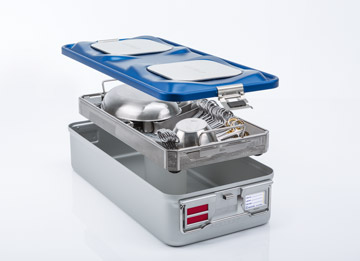
Aesculap
SterilContainer System
800-258-1946
Aesculap's rigid container system continues to expand its capabilities to ensure facilities can standardize on one method and brand of containers. The PrimeLine Pro Lid was recently added to the company's SterilContainer
JK and JN Series full, three-quarter and half-size containers. This 2 mm aluminum lid features an integrated reusable polytetrafluoroethylene (PTFE) filter designed for use in 2,200 steam or immediate-use sterilization cycles before
it needs to be replaced. The obvious benefit: Time savings and reduced processing costs because sterile reprocessing techs don't need to change the filter after each use.
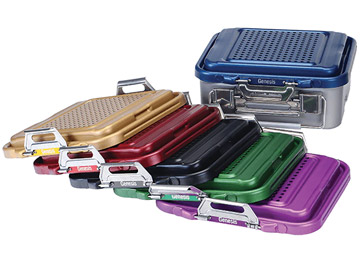
BD
Genesis
201-847-6800
Designed with hard coat anodized aluminum and available in a wide range of sizes and lid covers, this stackable container system offers a variety of baskets and accessories. It's also designed with thoughtful features
such as carrying handles that add support by bringing the arms and container close to the center of the body to help relieve stress on shoulders, back, arms and wrists; compression gasket sealing; a raised bottom to protect filter
integrity; double-sided data blocks that offer visibility from either side for easy instrument set identification; and tamper-evident arrows that visibly confirm the container hasn't been opened and has correctly undergone sterilization.
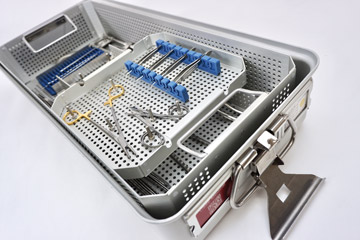
Case Medical
SteriTite Universal Sealed Container System
201-313-1999
SteriTite is billed as the only universal container system cleared for all sterilization modalities: steam, hydrogen peroxide, hydrogen peroxide/ozone and ethylene oxide. The containers, made of anodized aircraft-grade
aluminum, include offset filter retention plates to prevent strikethrough. Customizable options include internal baskets, inserts and components, with a library of designs available. Because the containers are cleared for five- to
eight-minute dry times for terminal sterilization, the vendor says SteriTite can reduce or eliminate the need for immediate-use sterilization.
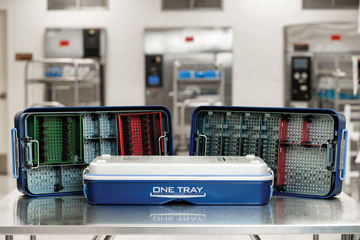
Innovative Sterilization Technologies
One Tray
937-619-0138
Innovative Sterilization Technologies says its One Tray system can save approximately 50% in reprocessing time because reprocessing techs can use three One Trays for every seven sterile wrapped trays, with an added bonus
of no drying or cooling time required. A new addition to the system is EZ-TRAX, an insert tray for organizing total joint instrumentation sets. The vendor says the trays reduce the cost and labor required to reprocess instrumentation
used in each total joints procedure by approximately 75%. A QR code on each EZ-TRAX tray links to surgeon-specific preference cards, pictures of complete instrument sets to ensure accurate reassembly, instrument cleaning instructions
and the manufacturer's instruction for use.
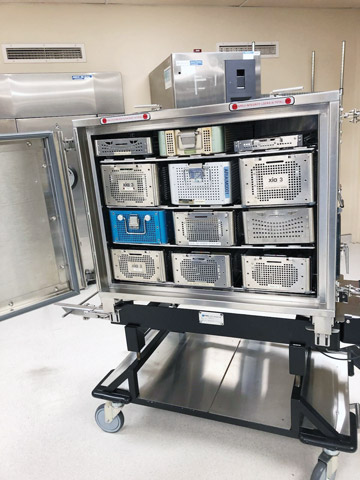
SteriCUBE
SteriCUBE
908-300-7093
The SteriCUBE is a multiple tray sterilization system available in 12-tray and 9-tray models. Surgical instrument trays are placed in the cabinet with no wraps or lids, eliminating many processing steps. ?The calling card
of this system is operational efficiency; ?after processing, the SteriCUBE can be rolled directly to the OR with surgery-ready instruments, or stored for up to 30 days without contamination. ?According to SteriCUBE, the system reduces
OR turnover time by an average of one minute per tray, lowers material and labor costs, eliminates surgical delays caused by holes in blue wrap or wet packs, and increases throughput and surgeon and staff satisfaction.
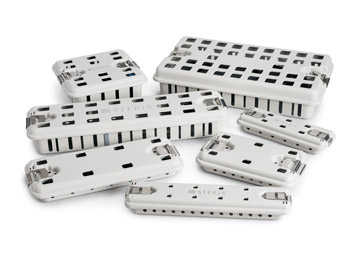
Steris
PRO-LITE ?Sterilization Trays
800-548-4873
Designed specifically for Steris' V-PRO ?Low Temperature Sterilization Systems, and also validated for use in STERRAD sterilizers, these trays are designed to maximize chamber shelf space. Available in a range of sizes,
each tray can accommodate up to 25 pounds of instruments, with instrument organizers securely holding items in place. New with the system is the ability to place trays inside pouches for more flexible packaging options.
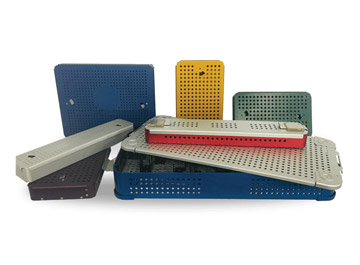
SteriZign Precision Technologies
Optimyz Sterilization Trays
888-234-3074
This semi-customizable line of sterilization trays ?offers flexibility. The system is based on pre-engineered and pre-validated trays with standardized sizes, perforations, brackets and latches. These elements can then
be customized with your choice of plating, colors, labeling and custom-designed silicone inserts. The composite sterilization tray systems are specifically designed for use with rigid and flexible endoscopes, endoscopic tools and accessories,
and micro-instruments and forceps. Other features of note include a perforation design for greater steam exposure, bottom perforations for easier drainage, soft rounded corners and a stackable design.
.svg?sfvrsn=be606e78_3)
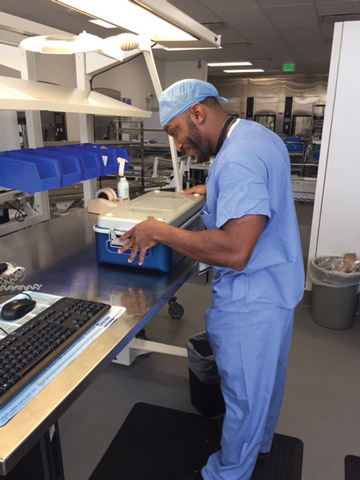
.svg?sfvrsn=56b2f850_5)